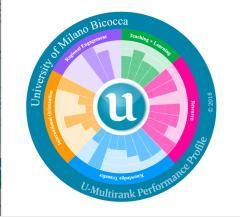The University of Milano-Bicocca in the rankings
The University of Milano-Bicocca has chosen to participate in the rankings that best represent its characteristics. These include: Times Higher Education, U-multirank and UI GreenMetric.
Milano-Bicocca participates in both the Times Higher Education World University Rankings and the THE Young University Rankings which, in particular, highlights the university’s qualities that are not linked to reputation, respecting the young age of certain universities.
Every year THE publishes its ranking of the best universities in the world based on factors such as teaching, research, international outlook, academic reputation, the staff-to-student ratio and other factors.
U-Multirank is the ranking established by the European Commission that allows users to rank universities according to their achievements in different areas: research, teaching and learning, knowledge transfer, international orientation and engagement at regional level. The European Commission will then seek to strengthen these areas as part of a project to modernise higher education.
The UI GreenMetric World University Rankings is an initiative launched in 2010 by the University of Indonesia to reward universities that help fight global climate change by reducing their carbon footprint. Milano-Bicocca, which was awarded 106th place in the world out of 619 universities involved, has been involved in environmental sustainability projects for years. In particular, thanks to the commitment of the University’s Infrastructure and Supply Department and the Bicocca Environment Society Economy (BASE) group, Milano-Bicocca has launched an integrated network of projects in the fields of energy, waste, mobility, climate change, water, food and education.

Teaching, quality of scientific research and ability to attract funding. These are some of the top indicators evaluated by U-Multirank, the independent international ranking funded by the European Union, which takes into account criteria such as the percentage of graduates, time to complete courses of study, scientific publications, international collaborations, student mobility and regional engagement. All major university and postgraduate studies are considered in the ranking.
The ranking analyses university performance on the basis of a set of indicators – about thirty – adopting a multi-faceted methodology. Five aspects are evaluated: teaching and learning, research, knowledge transfer, international orientation and relations with the local area in terms of graduates’ employment and partnerships with the local socio-economic system (“regional engagement”).
Milano-Bicocca has achieved the maximum score (1 - Very good) for the number of young people doing research in postdoc positions and for scientific publications with international and local co-authors, as well as for publications mentioned in patents.
The university is also rated positively for the number of citations in top publications (2 - Good) and for publications produced in partnership with industry. It also received a “Good” assessment for its ability to attract funding from abroad and at regional level.
With regard to “Teaching & learning”, a notable positive assessment (2) regards the number of students in the Master’s degree courses who graduate and the number of those in the course of graduating.